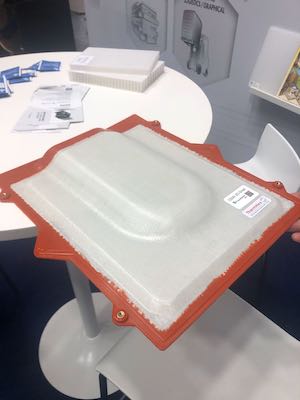Lower production costs through continuous processing is making such solutions more viable.
October 29, 2019

Innovative processing technologies are opening up more potential for utilization of polypropylene (PP) resin in today’s automobiles. One such example is the trunk floor of the Hyundai Creta subcompact crossover.
|
Foldable trunk floor incorporates honeycomb structure reinforced with GF-PP laminates and decorated with PET nonwoven. |
Here, PP-based honeycomb sheet supplied by ThermHex Waben GmbH, a subsidiary of the technology developer EconCore, is laminated with short glass fiber-reinforced PP skins and further compression-molded to a decorative PET nonwoven fabric. A living hinge is formed in the final compression molding process and this allows the trunk floor to fold up.
Speaking to PlasticsToday at the recent K Show, EconCore Chief Operating Officer Tomasz Czarnecki says the EconCore process now has 12 licensees globally, and there is significant scope for the technology to replace hardwood and other materials in auto applications. Citing another example, he said: “We have also worked with natural fiber-reinforced PP laminates and other structures to develop acoustic damping solutions enabled through the porous nature of EconCore, such as a door trim component.”
Outside of automotive, application is being investigated in industrial packaging, construction, and high-end applications like aerospace and trains. “We are trying to offer solutions to replace thermoset resins here,” says Czarnecki.
At the K Show, EconCore exhibited an organosandwich semi-finished product consisting of a PP honeycomb core and two glass fiber PP crossply skin layers. The special feature here is that not only the production of the honeycomb core but also the application of the skin layer takes place in a continuous production process at ThermHex. This The technology demonstrator is known as the OSW-3D shell and at K, a joint project between ThermHex and Fraunhofer IMWS, a process for the production of sandwich components such as the OSW-3D shell with thermoformed organosandwich and injection molding functionalization was also demonstrated. The developers Thomas Gläßer and Peter Stache from Fraunhofer IMWS succeeded in producing a component on a pilot scale within approx. 90 seconds.
The project supported by the European Regional Development Fund shows that sandwich components suitable for mass production can be produced with ThermHex honeycomb cores and further processed and functionalized in short cycle times. The project partners are confident that the automotive industry in particular will offer a wide range of possible applications.
About the Author(s)
You May Also Like





